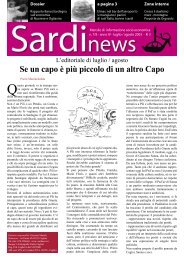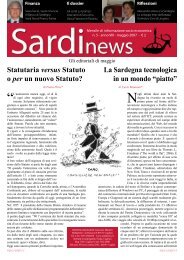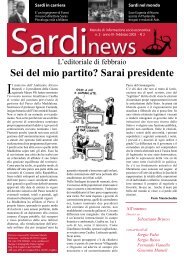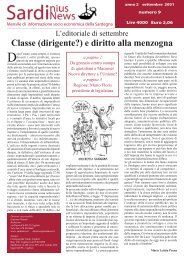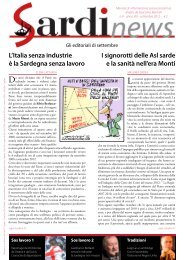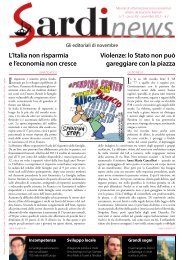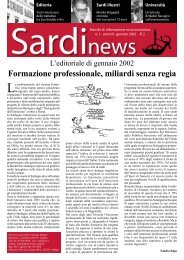Create successful ePaper yourself
Turn your PDF publications into a flip-book with our unique Google optimized e-Paper software.
The sky above us<br />
The Dish near Planu Sanguni i ready, Poggio dei Pini is now closing<br />
and a new Astrophysic centre is opening close the University Campus<br />
A Radiotelescope in the heart of Sardinia<br />
is a real technological challenge<br />
Nicolò D’Amico<br />
The radiotelescope’s future in Planu Sanguni<br />
– an area between San’Andrea Frius, Silius,<br />
San Nicolò Gerrei and San Basilio – was<br />
discussed in a public meeting organised by<br />
the Cuncordia Association in Sant’Andrea<br />
Frius with its leaders Valentina Loi and<br />
Gigi Melis. In the discussion local politicians<br />
spoke with the astronomers Luciano Burderi<br />
and Andrea Possenti. Nicolò D’Amico ,the<br />
project’s director, and author of the article<br />
written for <strong>Sardinews</strong>, introduced the topic.<br />
The Sardinia Radio Telescope (SRT) is<br />
almost ready, and very shortly it will<br />
be operative. Recently, the huge electromechanical<br />
structure was formally delivered<br />
by the Contractor to the local section<br />
of the National Institute for Astrophysics<br />
(INAF), the Cagliari Astronomical Observatory<br />
(OACa), whose headquarter is currently<br />
located in Poggio dei Pini, South of<br />
Cagliari. Various activities by the INAF<br />
technical staff are now in progress in order<br />
to install the scientific instrumentation<br />
and gradually proceed to the scientific validation.<br />
In parallel to these activities,<br />
the Contractor (MT-Mechatronics) is in<br />
the process to complete some additional<br />
works which should be delivered before<br />
next Summer. Calibrations and scientific<br />
validation by the INAF technical staff are<br />
rather complex activities. Though during<br />
this phase the instrument will be already<br />
operative and will be collecting real data,<br />
we expect to be waiting several months<br />
in order to offer the instrument to the<br />
scientific community for regular operations.<br />
As in other major facilities around<br />
the world, the use of this instrument by<br />
the scientific community will be based on<br />
a rather competitive protocol. Research<br />
groups around the world will be invited<br />
to submit proposal, typically on a sixmonths<br />
basis, presenting appropriate<br />
research projects. These projects will be<br />
evaluated by an international Time Assignment<br />
Committee nominated by INAF,<br />
which will be in charge to select the most<br />
promising projects and will assign a given<br />
amount of observing time. This is the<br />
same protocol adopted in all the major<br />
astronomical facilities around the world.<br />
In this scheme the running costs of the facility<br />
are in charge to the host institution,<br />
while no costs are charged to any given<br />
research group, which must only provide<br />
to it own internal costs. Of course, this<br />
protocol is based on the concept that a natural<br />
rotation occur, so that the use of our<br />
own facilities by external groups is compensated<br />
by the use other similar facilities<br />
abroad by Italian groups. In this respect,<br />
it is worth to remind that according to the<br />
most accredited rating agencies, Italian<br />
astronomers are among the most active<br />
users of the major astronomical facilities<br />
around the world such as the Very Large<br />
Array in New Mexico, the Green Bank<br />
Telescope in Virginia, the Hubble Space<br />
Telescope, and so on. So, from the Government<br />
point of view the sustainability<br />
of the management of an Italian facility<br />
such as the SRT, is fully justified. In addition,<br />
we should remind that under the<br />
pressure of the new ideas circulating in the<br />
scientific community, new focal plane instrumentation<br />
is continuously developed<br />
for such facilities. In the case of a radio<br />
telescope, such devices are mainly: new<br />
microwave receivers, new digital boards,<br />
new supercomputing equipments and so<br />
on. So, in the case of a radio telescope we<br />
are talking of a technological development<br />
in the field of electronics, telecommunications<br />
and ICT, and this development process<br />
creates a natural context of transfer<br />
of technology and training for our young<br />
people and for the local firms. In order<br />
to capitalize the above prospects, the<br />
OACa is about to move its headquarter<br />
in a new site. This is a dismissed military<br />
site in the Selargius Municipality, which is<br />
actually very close to the University Campus<br />
and so it is very close to the Physics<br />
Department of the Cagliari University,<br />
where various curricula in Astrophysics<br />
and related technologies are now offered<br />
to students. In this new refurbished site,<br />
large areas for laboratories and workshops<br />
are available, which provide the challenging<br />
perspective to grow as a modern research<br />
centre dedicated the development<br />
of new technologies. This new site will<br />
be mainly an “open site”. We want the<br />
public to come and visit us. Outreach<br />
facilities such an astronomical museum,<br />
a library, and a planetarium will be available.<br />
In addition, we plan to arrange a<br />
protocol with schools and local firms, in<br />
order to open our laboratories to young<br />
people for stages. Because this new site<br />
is rather close to the city, it represents the<br />
natural collector for attracting people and<br />
send them to visit the SRT site, which<br />
in turn represents an opportunity for the<br />
various villages close to the site.<br />
Let now have some a insight into the scientific<br />
aspects of the SRT. Traditional<br />
astronomy, and so the astronomical observations<br />
carried out at optical wavelengths,<br />
are rather familiar to most of us.<br />
22 marzo 2012



